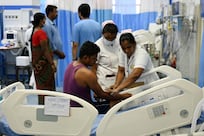A
bdulla Hashim, a senior vice president for information and communications technology for Etisalat UAE, talks about Emirates Energy Star, an initiative that aims to reduce the UAE's carbon footprint.
How does Emirates Energy Star (EES) work?
EES is the UAE's national energy efficiency programme by optimising energy usage in buildings through 24x7 real time monitoring and control. The programme, set up by Etisalat and Pacific Controls, aims to reduce 20 per cent of energy consumption and 20 per cent of the carbon footprint among its customers by 2015. The programme is endorsed by the UAE's Ministry of Environment and Water. Besides the obvious cost savings for the end user in the form of lower energy utility bills, the EES programme also helps decrease pollution and enables the UAE's drive to become one of the smartest countries in the world as per its Vision 2021, by significantly reducing its per capita carbon emission. EES has saved 18,730 tonnes of carbon dioxide throguh July since it was started in December. This is equivalent to planting 4,022 trees and has resulted in cash savings of Dh11.3 million for the building owners participating in this programme. The most updated information on a monthly basis can be accessed from the EES dashboard at http://www.etisalat.ae/emiratesenergystar
When did it start and which buildings are part of the project?
EES was launched in December 2011. Currently, over 79 buildings have been connected to the EES programme, covering the whole gamut of low-rise to high-rise buildings. These comprise an entire spectrum of buildings like high-rise residential and commercial towers, hospital, shopping mall, mixed-use complex, hotel, academic institutions and business centres. Some of our key partners include Abu Dhabi Commercial Bank, the Ministry of Social Affairs, Dubai Municipality's Al Twar Centre, Al Rostamani's 21st Century Tower, First Gulf Bank in Dubai, and Deyaar's Al Barsha headquarter building.
While the majority of these buildings are commercial, residential buildings form the next big category. These buildings largely represent the public, government and education sectors, followed by construction and industry. The banking and finance sector forms the third-largest segment participating in this programme.
How much does it cost the consumers and Etisalat?
The monthly subscription for customers is customised according to specific needs and this is decided after careful monitoring of the buildings. EES is achieving an average energy reduction of 19 per cent. The average return on investment across these projects is eight months. Etisalat's ICT strategy includes high investment in the machine to machine (M2M) industry, where energy management is one of the vertical solutions. All these solutions, including EES, use the Etisalat network and infrastructure, including Etisalat M2M SIMs. Etisalat, with its partner Pacific Controls, runs the programme on the lowest investment from participants where the cost of connectivity, hardware and global command control centre has been taken as an initial investment to launch the EES programme.
How does Etisalat plan to scale up the initiative?
In 2012 several organisations signed up for their first buildings into the programme. Having seen the results for several months, they are now signing up entire portfolio of their assets. We also see a major shift in the government sector to engage in the programme as they see the savings returns and are keen to drive a greener economy.
How many more buildings will come under the energy saver programme by the end of 2013?
We expect to double the number of participants before the end of 2013.
What are the requirements for a building to hook up to the energy saver system?
Any "facility owner" can participate in this programme. Facilities interested can approach any Etisalat business centre or the respective Etisalat sales manager responsible for their account. The EES team will present to the facility owner the concept detail, methodology of implementation and triple bottom-line benefits. On expression of interest by the client, an energy survey will be conducted of the facility in question. This will involve a thorough study of the equipment and building occupancy pattern, equipment ratings and usage, and historical energy consumption data.





